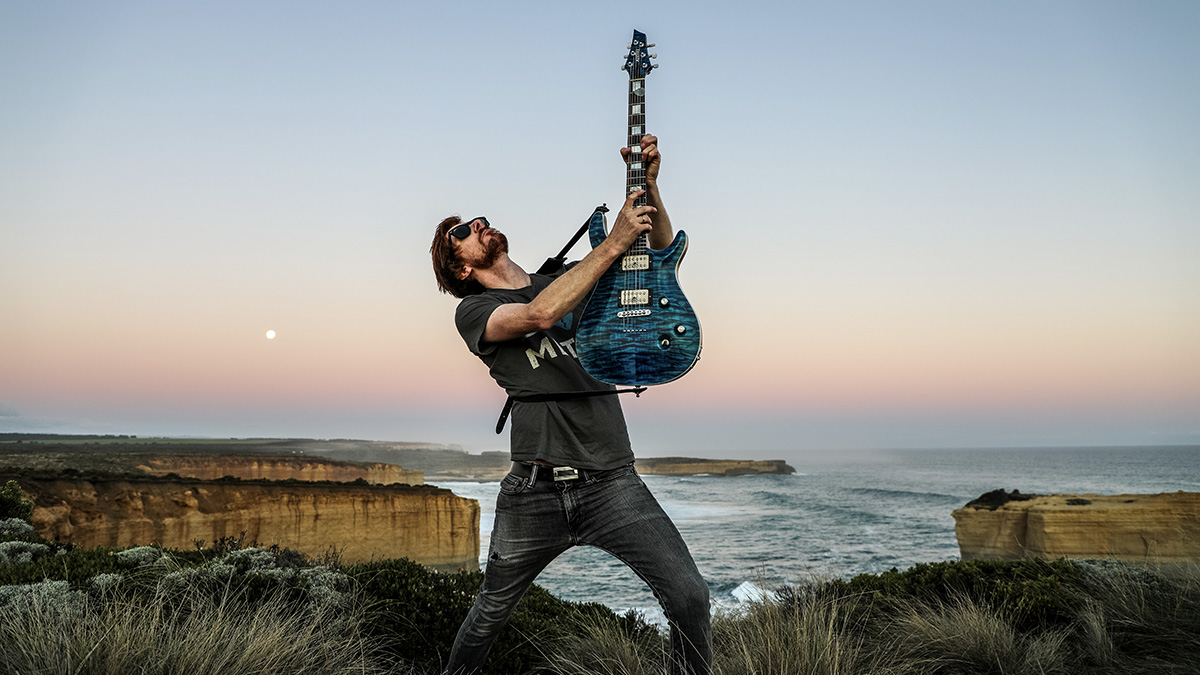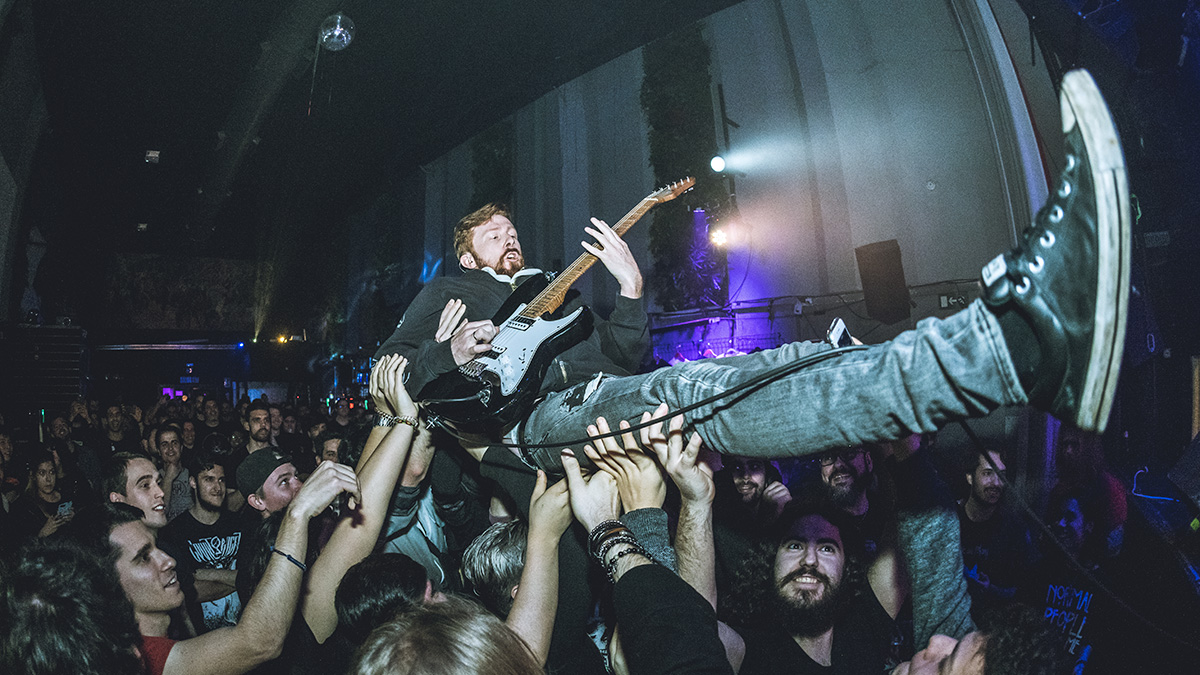I Built the Sky’s Rohan Stevenson on breaking out of the shred-metal box for an acoustic guitar album that makes space for banjo, xylophone and more
Stevenson is a prog-metal player who lights up the fretboard, but for The Quiet Place Away, he follows the inspiration of Tommy Emmanuel for an intimate, all-acoustic album

While Rohan Stevenson’s body of work as I Built the Sky features plenty of high-gain, eyebrow-singing electric runs – just last fall he and Jake Howsham Lowe went buck wild with gymnastic flair on their Coalesce EP – the progressive shredder has always had a soft spot for the tender tone of a finely strummed acoustic guitar.
In the past, he’s tucked the occasional unplugged piece onto an album, but he’s gone full-fledged acoustic for his latest 10-song release, The Quiet Place Away.
Stevenson’s approach to acoustic music is nevertheless as complex as his metal oeuvre – take Where Sea Meets Sky, where the guitarist is busy rustling through elastic pull-offs and rapid-fire natural harmonics.
But the record also features some wide-open expanses, Stevenson’s oaky, open-tuned strums enriched by robust string arrangements, and opal-delicate piano work from Wolfmother’s Ian Peres.
Broadening out from the metal realm, Stevenson cites fellow Australian acoustic guitarist Tommy Emmanuel as inspiration for The Quiet Place Away, as well as the percussive approach of French-Canadian player Antoine Dufour.
The lush, emotional sway of 5/4 heart-tugger This Is Astral Travel, meanwhile, conjures the post-emo polyrhythms of American Football/Owen guitarist Mike Kinsella, among others.
The Quiet Place Away is also the first I Built the Sky release to find Stevenson experimenting with xylophone and six-string ganjo – the latter most prominently plucked on the thistle-chewing title track.
Get The Pick Newsletter
All the latest guitar news, interviews, lessons, reviews, deals and more, direct to your inbox!
“I’m independent; I don’t have to check off music with anyone else, so I get to fully choose what I do,” he says of carving his own musical path. “I love heavy riffs. I’m going to do more of that, but [with] this one… I wanted to encapsulate chilled-out, soothing vibes. There are moments of intensity along the way, but it’s trying to take you away from all the noise and the chaos, and put you [inside] that quiet place.”
How long had you been wanting to do a full-on acoustic album?
“I’ve always chucked a song on a release, just as a bit of a contrast to what I normally do. As a writer, it’s a fun challenge to write music that’s away from the general metal/shreddy stuff. Along the way, though, it’s definitely been in my mind that I should commit to at least an EP [of acoustic music]. When Covid happened, it gave me room to lock myself down and finish it off.”
Were there any particular elements to your style or technique that you’d hoped to recontextualize in an acoustic setting?
“The arrangements, for the most part. You know, like adding things mandolin and banjo, or percussive elements like xylophone. With the metal stuff, it’s pretty much rock band format. With this one, it’s wide open. We can use different instruments. I wasn’t afraid to try a dobro guitar, or all these different instruments.
“Xylophone is very hard to play, by the way. That was a bit of a challenge.”
How about the banjo playing on the title track? Was that a new instrument for you as well?
“Definitely. I’d never played banjo before – never even touched one in my life. I [actually] got a Ganjo – it’s six-strings and it’s tuned like a guitar, but with a banjo sound. That enabled me to learn it more efficiently for these recordings. It’s not on every song, or anything like that, but it’s sprinkled in there.”
You incorporate natural harmonics all over this album, and in different ways. I’m thinking about the way you busily pop off harmonics within the lead lick of Let Yourself Dream, but also how they’re used as more of a background, grace note texturing in the chorus of This is Astral Travel…
“I love harmonics. I think they work so well on acoustics. Any chance I can slip them in there, I go for it. The guitars are in open tunings, so that also helps. You play a harmonic anywhere and it sounds like a nice chord. It’s something that comes quite naturally to me.”

Were you sticking with one general open tuning?
“There are two main ones that I use, but I can’t tell you off the top of my head what they are. I just know how they sound. One’s minor based, and one’s major based, so I think that helps set two different, distinct vibes from the get-go.”
You’ve raved about Maton Guitars in the past, and have showed off some of those guitars on Instagram. How big is the collection, in general, and how many Matons were a part of this particular session?
“I’ve got a few vintage [pieces in the collection]. Maton are an Australian brand, and they really specialize in acoustic guitars – Tommy Emmanuel is a notable player that uses them a lot.
“I’ve got this custom shop Maton that’s really nice. It’s got ziricote wood at the back and sides. It looks quite distinct when you see it; it’s quite interesting because it’s got a light blond wood colour mixed with dark brown, but it’s the same piece of wood. It sounds amazing, too. I used that for 90 per cent of the album. I’ve got a few vintage electrics from the ‘60s as well, and a few other more modern electrics.”
A post shared by @ibuiltthesky
A photo posted by on
Did you labour over finding a solid acoustic tone on this record, similarly to how you might while dialing up a rig or plug-in for the electric material?
“In some ways, yes. What we did is we used more mics, and put [them] around different spots [of the room]. We had those options available to blend in the mixing process.
“I recorded in two separate locations. Most of the guitar work was done in an Airbnb in the Otways, which is this really lovely stetting. We did a few more [sessions] adding mandolin, banjo, and percussion in a studio [Qsound Studios] with [producer] Forrester [Savell]. There, I felt like [we were] sitting there in front of 15 mics – Heaps of mics!”
Getting back to your Maton: in the video for “Let Yourself Dream,” you end up taking a dip in a lake with your acoustic guitar; you actually start pouring water out of the soundhole at one point. Was that a gimmick guitar, or your main Maton?
“I bought a cheap guitar that looked as much like the one I’m playing as possible. Its definitely not a Maton – I would never to do that to such a beautiful instrument. This was a really cheap one that I wouldn’t even want to give to a beginner, because it’s just useless [laughs]. Totally expendable.”
How did it handle after taking a bath? Did you try to play anything with that soaked wood?
“I gave it a look a few days after, and it seemed fine. I don’t know if it’s to do with that laminate wood, but it actually came off not too bad.”
What can you say about the locations for your latest group of music videos? You seem to be drawn to these natural settings at the moment.
“Those were all shot at the Otways region in Victoria, about three hours out of Melbourne city. It’s just this real scenic area. You go anywhere [around] there and it’s beautiful. Especially because of these acoustic [arrangements], I wanted to convey that relaxed, chilled-out, natural vibe.”
Did you end up writing any of these songs in that kind of a setting, or was this all done at home?
“Typically, on my couch at 3AM is when I would be creating the riffs – something about the silence of that time of night, you know? It allows me to focus.
“I think the main difference when I write metal stuff [is that] I’m riffing to drums. I’m in front of the computer, but with this acoustic stuff I was on the couch; I was away from the computer screen. I wasn’t out in some natural area, unfortunately.”

There are some impressively complex riffs across the album, but there aren’t a ton of leads. The record’s New Universe might be the one exception.
“I think that’s my natural inclination in this type of setting. Of course, I could shred. In some of those acoustic songs I’d released prior to this, there’s a bit more shredding going on.”
There are some wild acoustic runs on your Hyperion single [from 2018] …
“I think Hyperion worked quite well – it’s really entertaining, there’s lots of flashy stuff going on – but with this album I didn’t feel the need to insert that kind of stuff. I just wanted to follow the sounds, keep it relaxed, and contrast from what I do with the metal stuff. I didn’t overthink it. When I create, it’s a very subconscious process.”
There’s a subtle complexity to the 5/4 feel of This is Astral Travel. It’s quite spritely.
“That’s another one that [came subconsciously] in the writing process. It wasn’t until I stepped away [from it] that I thought there was something weird about the timing. That’s probably my favourite song on the whole album. It’s got an uplifting vibe to it, which I really enjoy. That one came together quite quickly.”
Leading up to this release, you’d brought up that one of the big differences between making an electric record and an acoustic record is the unforgiving nature of an acoustic guitar. Was that a challenge for you, in terms of knocking your takes down?
“Huge challenge. I mean, with the harmonics and chords, you really need to nail those – you need to nail them on electric as well, but even more so with acoustic. When you’ve got distortion on, you’ve got leeway with some of those notes, but [with] the acoustic guitar there’s no help. So, if you don’t quite hit the harmonic right on the fret, it might not ring as nicely as you need it to. It does take a few times.
One of the things that we came across is that I wouldn’t actually be strumming hard, but then when you listen back, the sound is a bit too aggressive
“One of the things that we came across is that I wouldn’t actually be strumming hard, but then when you listen back, the sound is a bit too aggressive – it wasn’t as soothing as I was hoping for. We ended up using softer picks, and [were] a bit more aware of the strumming so that it didn’t spoil the chords. We actually had to re-record a bunch of songs knowing that we had been strumming too hard through the takes.”
How drastically were you gauging down with your picks?
“We only went down one step. I naturally use a lighter pick, a .73mm. I think we went used .60mm for the end result.”
With the album’s penultimate track in mind, When I Leave This Earth, how do you feel this full-fledge acoustic experiment reflects the overall legacy you’ve been building with your playing?
“I just want to share that there’s this side of me as well. I like to make chilled out music; I like to experiment; I want to push myself with my writing; I want a body of work that’s diverse, you know?
“I don’t just want to be known as the shred metal guy, which is kind of what I am, I suppose. That’s not a chip on my shoulder, or anything like that, but I love acoustic music, [too]. I enjoy creating it as much as the metal the stuff.”
- The Quiet Place Away is out now.
Gregory Adams is a Vancouver-based arts reporter. From metal legends to emerging pop icons to the best of the basement circuit, he’s interviewed musicians across countless genres for nearly two decades, most recently with Guitar World, Bass Player, Revolver, and more – as well as through his independent newsletter, Gut Feeling. This all still blows his mind. He’s a guitar player, generally bouncing hardcore riffs off his ’52 Tele reissue and a dinged-up SG.





![[from left] George Harrison with his Gretsch Country Gentleman, Norman Harris of Norman's Rare Guitars holds a gold-top Les Paul, John Fogerty with his legendary 1969 Rickenbacker](https://cdn.mos.cms.futurecdn.net/TuH3nuhn9etqjdn5sy4ntW.jpg)





